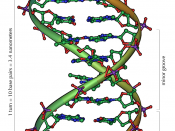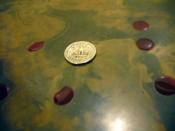The controversy exists on the causes of wrongful convictions across the country in recent years. In this paper our group will discuss the causes of wrongful conviction also known as a miscarriage of justice. This essay will also discuss ways in which the court system can help to reduce or eliminate these causes.
DNAAs the pace of DNA exonerations has grown, wrongful convictions have revealed disturbing fissures and trends in our criminal justice system. Some of these cases together show us how the criminal justice system is broken and how urgently it needs to be amended. America as a society should learn from the system's failure and drawbacks. In each case where DNA has proven innocence beyond a reasonable doubt, an overlapping array of causes has emerged from mistakes to misconduct to factors of race and class.
In recent years the cases are countless of those exonerated by DNA testing are not only people who have been wrongfully convicted.
For those defendants every case that involves DNA, there are thousands that do not. In those cases a fraction of criminal cases involve biological evidence that can be subjected to DNA testing, and even when such evidence exists. It is only then when the evidence is lost or destroyed after the conviction. During our search it was determined that some of the smaller jurisdictions do not have access to a definitive test like DNA and many wrongful convicted people have little or no chance of ever proving their innocence.
Second, through our group efforts during our search of wrongful convictions it was determined that eyewitness misidentification is the single greatest cause of wrongful convictions nationwide (The Innocence Project, 2008). These wrongful convictions played a role in more than 75% of convictions overturned by DNA testing (The Innocence Project, 2008). We agree that eyewitness testimony can be persuasive evidence before a judge or jury; 30 years of strong social science research had proven that eyewitness identification is often unreliable. The research which was conducted by innocence project revealed that the human mind is not like a tape recorder or video camera; we neither record events exactly as we see them, nor recall the like a tape that has been rewound. Nevertheless, witness memory is like any other evidence at a crime scene, it must be preserved carefully and retrieved methodically, or it can be contaminated. We as people can carry fibers, through our shoes and skin that will cause the contamination of a crime scene just by walking through the crime scene. Furthermore, in these types of cases, DNA has proven what scientists already know, that eyewitness identification is frequently inaccurate.
The wrongful convictions caused by eyewitness misidentification, and the circumstances varied, but judges and juries and police officers at a scene all relied on testimony that could have been more accurate if reforms proven by science had been implemented. In many police departments across the nation have implemented video cameras which are installed in police vehicles to provide the judge and juries what exactly took place at a crime scene. These law enforcement agencies are asking residence and business owners to install video and audio equipment to better service if an encounter with a suspect(s) takes places, so that the video can later be used against him or her at a court hearing.
Many experts have known that eyewitness identification is all too susceptible to error, and that scientific studies should guide reforms for identification procedures. Since then hundreds of scientific studies have affirmed that eyewitness identification is often inaccurate and that it can be made more accurate by implementing specific identification reforms (The Innocence Project, 2008).
Forensic ScienceBecause forensic science results can mean the difference between life and death in many cases, fraud and other types of misconduct in the field are particularly troubling. False testimony, exaggerated statistics and laboratory fraud have led to wrongful conviction in several states. Since forensic evidence is offered by "experts," jurors routinely give it much more weight than other evidence. But when misconduct occurs, the weight is misplaced. In some instances, labs or their personnel are too closely tied to police and prosecutors, and therefore, not impartial. Other times, a criminologist lacking the requisite knowledge embellishes findings, confident that he will not be caught since the lawyer; judge and jury have no background in the relevant science.
In some cases, critical evidence is consumed or destroyed, so that re-testing to uncover the misconduct is impossible. Evidence in these cases can never be tested again. Those wrongful convictions will never be overturned. The identification, collection, testing, storage, handling and reporting of any piece of forensic evidence involves a number of people. Evidence can be deliberately or accidentally mishandled at any stage of this process. The risk of misconduct starts at the crime scene, where evidence can be planted, destroyed or mishandled. Then the evidence is sent by police to a state forensic lab or independent contractor, where it can be contaminated, poorly tested, consumed unnecessarily or mislabeled (Deedrick, 2000). The next step is a report, in which technicians and their superiors sometimes misrepresent results. DNA exonerations have revealed numerous instances of "drylabbing" evidence - reporting results when no test was performed. It is cheaper and faster - but can be fraudulent.
The Innocence Project has uncovered these abuses since 1992 and has developed recommendations for crime labs, law enforcement agencies and courts to ensure that forensic science misconduct is prevented whenever possible (Deedrick, 2000). The Innocence Project calls for state to impose standards on the preservation and handling of evidence. When exonerations suggest that an analyst engaged in misconduct, or that a facility lacked proper procedures or oversight the Innocence Project advocates for independent audits of their work in other cases that may have also resulted in wrongful convictions.
George Rodriguez was exonerated in 2005 after serving 17 years for a sexual assault he did not commit. Rodriguez's case helped to reveal a pattern of error and fraud in the Houston Police Department Crime Lab that is still being investigated and corrected today (The Innocence Project, 2008). In Rodriguez's case, lab director Jim Bolding testified that a hair found in the victim's underwear could have belonged to Rodriguez. He also testified that blood type evidence showed that Rodriguez, not a co-defendant, could have deposited biological fluids. This was false; later tests showed that the co-defendant could have been a contributor. DNA testing also showed that the hair used against Rodriguez could not have been his. Audits of the Houston lab since Rodriguez's exoneration have revealed a wide range of misconduct.
Forensic science errors both inadvertent and calculated are a leading cause of wrongful convictions. Despite several lab scandals across the country in recent years which show that innocent people were convicted because of crime lab errors, and notwithstanding the important efforts undertaken by some accrediting entities to address this issue, states have historically done little to investigate or remedy these problems and ensure the integrity of forensic evidence. The Innocence Project supports the forensic community in its ongoing fight for the funding it deserves as caseloads grow and the public becomes more demanding. Crime victims, police, prosecutors and courts all gain from an efficient system that minimizes errors and focuses resources on the punishment of the guilty.
The following recommendations, developed by the Innocence Project during years of research and experience, can substantively address laboratory fraud and error:Create an accreditation system: All laboratories testing forensic evidence for use in courtrooms must be reviewed regularly by an external agency. All technicians should be licensed. Form oversight commissions: Independent panels should be created in each state to review the forensic methods that are accepted in state courtrooms and to investigate allegations of misconduct, negligence or error in labs. Enforce requirements that are already in place: Many states receive federal grant money under the Paul Coverdell Forensic Science Improvement Grant program (United States Department of Justice, 2008). This grant money comes with the requirement that the state conduct independent investigations into any allegations of misconduct. Many states have accepted the grants but have not complied with this requirement.
False Unreliable EvidenceFalse unreliable evidence in an investigation is repeated questions on witnesses that may provoke the witness to fabricate events concerning a crime that never occurred. Although a witness may first deny an event or crime, false memories often develop through the imagination's response to persistent inquiry. Because a certain amount of suggestive questioning may be needed to convince a witness to disclose valuable information, difficult questions and lies in determining whether the witness response is authentic or induced by police or investigators by repetitions of aggressive questions. Accounts of false memories are often quite believable.
This substantiates concern over the reliance of judges and juries on a witness testimony when it is the only available evidence in legal cases. This is true, in a 1993 study of children ages four to six, researches from Chicago found that after 11 weeks of personal questioning 56% of young witnesses reported at least one false event as a true (Union of International Associations, 2008). Innocent people were sentenced to prison; the charges were based on solely false unreliable testimonies evidence. It is also true that with more intensive investigation several convictions where overturned, as researches raised more questions about potentially unreliable evidence of persistent inquiry.
Police need to exercise particular caution when adults aged 60 or over make a positive identification during a police identification line-up parade. A study of the accuracy of eyewitness testimony among a sample of people aged 60-80 reveals disturbing results. While young people make mistakes during identifying defendants, researchers argue that false unreliable evidence are convicting innocent people, some to the extent that some defendants are even on death row (Union of International Associations, 2008).
All things considered, the problem of wrongful conviction in America is much larger than many of its antagonists appreciate, but that should not stop Americans from trying to seek out the truth to release a few innocent people. Daily throughout this country people are convicted of crimes they did not commit, or worse, set free when chains of investigators fail to prosecute properly those guilty of a crime. The future of our criminal justice system's success relies profusely on today's education system and the hiring process of individuals. A solid education system will produce competent and reliable police officers, forensic scientists, lawyers, and every other role player in this world of crime. More knowledgeable and competent employees in the criminal justice system will be better equipped with the tools they need in order to reduce or possibly eliminate these errors that exist in today's system.
ReferencesDeedrick, Douglas W. (2000). Hairs, Fibers, Crime and Evidence. Forensic Science Communication, 2 (3). Retrieved April 27, 2008, from Federal Bureau of Investigation database.
The Innocence Project. (2008). Witness Misidentification. Retrieved April 28, 2008, from http://www.innocenceproject.org/understand/Eyewitness-Misidentification.phpUnited States Department of Justice. (2008). Coverdell Forensic Science Improvement Grant Program. Retrieved April 27, 2008, from http://www.ojp.usdoj.gov/nij/topics/ forensics/nfsia/welcome.htmUnion of International Associations. (2008). Unreliable Evidence of Children. Retrieved April 27, 2008, from http://www.diversitas.org/db/ x.php?dbcode=pr&go=e&id=12005620


